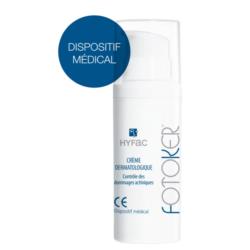
What is actinic keratosis? How is it treated?
Under the complicated name of actinic keratosis lies one of the most common skin conditions in the world!

Actinic keratoses are small spots flat or slightly raised (pinkish, yellowish, sometimes brown), rough or rough to the touch, often covered with a small adherent "crust", more or less thick. They occur exclusively on the areas typically exposed to sun : face (forehead, ear, nose), scalp (in bald people), neck, neckline, back of the hands, and sometimes on the legs.
They are mainly found in people with fair skin (red, blond, rarely on dark skins and never on black skins) being often exposed to sunlightThey are used either for leisure or for their professional activity (sailors, farmers, sportsmen, construction workers, etc.).
L'sun exposure during the summer is not the only risk factor. Being outdoors regularly and exposed to the sun's rays all year round, even under cloudy skies, represents a significant risk of developing actinic keratoses.
How do actinic keratoses form?
The older the skin gets, the more actinic keratoses appear. The skin remembers sun exposure throughout its life (sun capital). It is therefore most often after 50 years that actinic keratoses appear. This is often accompanied by a skin aging on exposed areas. The skin becomes thinner, fine lines form and small pigmented spots appear on the face, neckline and back of the hands.
The UV rays of the sun attack the DNA of the skin cells and, in the long term, cause mutations in the genes of these cells. This can lead to the development of cancer cells.
Are actinic keratoses skin cancers?
Actinic keratoses are not only a cosmetic problem, and must be treated very seriously by a dermatologist. Their presence means that the skin has suffered from a chronic sun exposure. The skin is more likely to develop cancer in areas affected by actinic keratoses. Not all actinic keratoses develop into skin cancer, only some of them will.
Actinic keratoses are then a red flag which should lead to systematic protection during outdoor activities.
How to treat actinic keratoses?
Dermatologists often see patients with actinic keratoses in consultation. There are different ways to destroy them. However, the destruction of actinic keratoses is not sufficient, it is therefore necessary to prevent their occurrence. Today, there are pharmacies that sell prevention products which are not only sunscreens, but which allow to repair damage This is particularly important for patients with light skin. This prevention is particularly important for patients with a fair complexion.
You should also be aware that exposure to the sun is not always voluntary. All sun rays do not warm us up. UV rays are cold, so we don't feel warm when we are exposed to UV rays. For example, we are not necessarily aware of being exposed when it is overcast in March. However, the frequency of actinic keratoses is greater in Normandy than on the Mediterranean coast. Normans have fairer skin and are not wary of the sun, even when the weather is cool. It is therefore essential to protect your skinWe can also protect the exposed areas of the face and hands by using sun protection products (anti UVA and UVB) every day when we go out!




